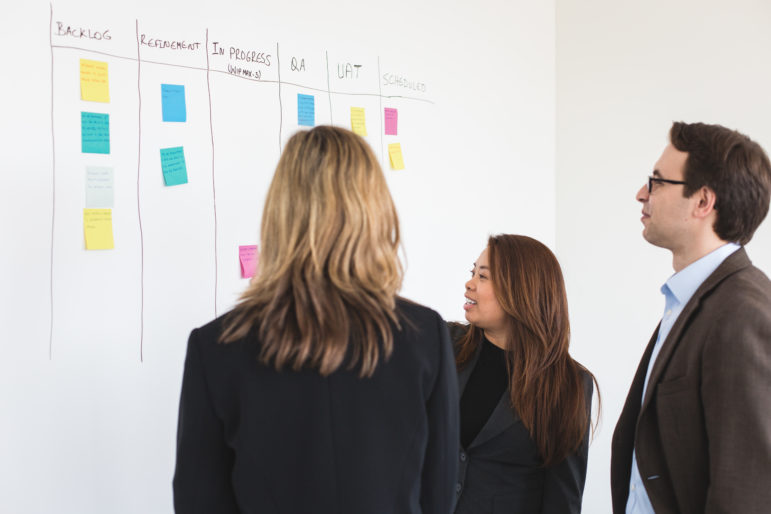 A few months ago, my colleague wrote an excellent blog about how to build user-centric products. She brought up a critical point: user experience matters because users matter. Simple, but so true. By collaborating with your users from the start to fully understand their needs and expectations, your team is better equipped to design products and solutions your users will embrace.
A few months ago, my colleague wrote an excellent blog about how to build user-centric products. She brought up a critical point: user experience matters because users matter. Simple, but so true. By collaborating with your users from the start to fully understand their needs and expectations, your team is better equipped to design products and solutions your users will embrace.
While this may seem like a straightforward concept, designing for and collaborating with your users is often much more difficult in practice. How do you ensure that your collaboration efforts with users are not only meaningful, but structured enough to be both productive and actionable? This is a challenge we encounter time and time again. Below, I describe several strategies and best practices for eliciting ongoing feedback and co-designing solutions with your core users.
Adopt the Right Mindset
It’s essential that your team members embrace a collective mindset around collaboration and what that can and should entail. Here are some characteristics that are absolutely essential for a team to adopt for effective collaboration:
- Don’t let egos stand in the way of success – Innovation can come from anyone, especially your users. Be humble, and listen without preconceived notions of what the solution is.
- Empathy is the basis for success – Empathy allows your team to develop solutions that are both innovative and responsive to real users’ needs and desires. Empathy also helps teammates respect each other’s perspectives and communicate well.
- Be agile – At EK, when we talk about agile, we say that you don’t do agile, you become agile. Agile carries over into UX constantly, because during your collaborative efforts, you’ll never have all the answers. Embrace the uncertainty and be willing to implement designs in an agile way; in an iterative manner and without knowing all the details and requirements.
Set Expectations from the Start
Your first conversation with end users is absolutely critical for setting a tone that is friendly and open to carry through the duration of the project. Whenever you begin an initiative with end users, engage them in conversations as soon as possible to gather their ideas, challenges, and situations. Doing this results in two key benefits. First, you immediately start gathering critical data and anecdotes to inform your future designs. Second (and more importantly), these conversations build trust with end users, thereby strengthening the understanding that you are working together to address the challenge, which will better ensure engagement, buy-in, and overall adoption down the road. Set expectations about the project, be honest about potential obstacles, and transparent about your processes. Doing so will further build trust and rapport with your users.
Select the Right Approach
There’s never a “one size fits all” approach to user collaboration, so it’s essential for your team to engage users in ways that make them comfortable with contributing. The more comfortable users are, the more likely they are to offer candid, authentic information and feedback, which leads to deeper and more nuanced understandings.
At a high level, here are some guiding questions to help you determine what collaboration approach to use with your users:
- How often do your users want to hear from you? Every day, week, or only at critical points in the project?
- How do your users currently communicate and collaborate? Do they prefer more structure and formality, or less?
- What is the problem or challenge that needs to be collaboratively solved?
- What results ideally need to be produced as a result of collaborating?
 Every situation necessitates a different method, and in some instances, you may combine several collaboration approaches to achieve your end goal. It’s critical to consider the ideal outcome for your collaboration efforts, as this will inevitably shape the format for the exercise. For instance, maybe your team has to gather as many ideas for potential solutions as possible. A timeboxed brainstorming session where participants are encouraged to write and sketch as many ideas as possible would be a potential fit. In another example, perhaps your team has a slew of potential features for an app and needs a clear direction for moving forward. Here, it makes more sense to collaborate around “sense-making” – grouping and categorizing ideas into themes, with a dot voting exercise to prioritize.
Every situation necessitates a different method, and in some instances, you may combine several collaboration approaches to achieve your end goal. It’s critical to consider the ideal outcome for your collaboration efforts, as this will inevitably shape the format for the exercise. For instance, maybe your team has to gather as many ideas for potential solutions as possible. A timeboxed brainstorming session where participants are encouraged to write and sketch as many ideas as possible would be a potential fit. In another example, perhaps your team has a slew of potential features for an app and needs a clear direction for moving forward. Here, it makes more sense to collaborate around “sense-making” – grouping and categorizing ideas into themes, with a dot voting exercise to prioritize.
Add Focus and Structure
We’ve all been in meetings that lack clear objectives and direction, and we recognize that it’s frustrating to participate in seemingly aimless conversations. Therefore, it’s essential, especially when collaborating with your users, to create structure in order to ensure progress.
When people hear the word “structure,” many equate it to “rules,” which sounds counterintuitive to collaboration. However, without these parameters, it’s inevitable that group politics and policies will drive the conversations, limiting the group’s potential. To that end, planned collaborations need to balance a range of communication styles and preferences, as well as group interactions. To start, work as a group to collectively define ground rules facilitate good collaborative behavior. Be sure to establish timeboxes to help participants avoid getting stuck, and utilize an array of activities to engage both introverts and extroverts. For example, having individuals participate in a silent brainstorming session followed by report-outs will ensure everyone has a format that is more comfortable for them, and that they each have a voice. In some scenarios it is also helpful to assign roles of note-takers, facilitators, etc. to participants so that everyone feels they have a purpose.
Closing
Collaboration may sound simple, but it’s much more difficult to effectively practice, especially when you and your team are often dealing with a wide range of users, all with varying objectives, needs, and expectations. Despite these challenges, the value of collaborating with your users is clear. When you design with your users, you ensure your team understands the whole picture, and builds out products and solutions that are not only usable, but delightful.
Interested in learning how to more effectively collaborate with your end users? Contact us, we’re happy to help!
